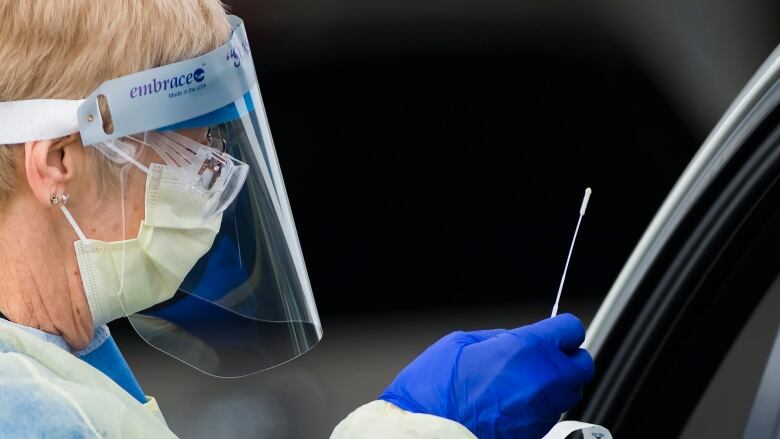Manitoba COVID-19 numbers low since reopening, but experts warn against complacency
Manitoba has 16 active cases of COVID-19 as of Saturday; no one in hospital

Two weeks into Phase 3 of Manitoba's reopening, new cases of COVID-19 in the province are at a steady trickle but epidemiologists warn it could still roar into a flood if Manitobans don't stay cautious.
"Don't get complacent yet," said Cynthia Carr, a Winnipeg-based epidemiologist and founder of EPI Research Inc. "It just takes one [case] to become an outbreak."
It's been roughly nine weeks since Manitoba set out on the first stage of a multi-phased plan to roll back pandemic restrictions on May 4.
Since then, Manitoba has identified 45 new cases of COVID-19. Twenty-seven of them have been in the Winnipeg health region, 10 in the Southern health region and eight in Prairie Mountain Health.
Manitoba's other two health regions, Interlake-Eastern and Northern, haven't announced any new cases since April.
Some of those cases came in clusters, including a 10-case cluster at Brandon-based trucking company Paul's Hauling. Four others were temporary foreign workers who lived and worked together in the Southern health region.
At least 14 of the cases were connected to the trucking industry, either working as truck drivers or close contacts of truckers who tested positive. That doesn't include the Paul's Hauling outbreak, where the province has yet to publicly announce how the first person got sick.
The apparently low number of community spread cases over the past couple of months is encouraging, but Manitobans shouldn't breathe a sigh of relief yet, Carr says.
Manitoba's low numbers are good for public health but pose a problem for experts or observers trying to interpret them, she said. When the overall numbers are so low, perceived patterns might just be flukes.
"Proportionally we could say a high rate of them are related to [travel and contact with known cases]. But the reality is, you can see in other areas across the country and around the world where there's more cases, there's still general spread," she said.
"We don't want to get complacent and say, 'OK, it's the people travelling across country for their jobs that are at higher risk, and not the rest of us.'"
Through a peak, into a trough
Manitoba has identified 325 lab-confirmed positive and probable positive cases of COVID-19 since March 12, when the province announced its first three cases.
As of Friday,16of them were active. Seven Manitobans have died. A total of 302 have recovered.
It's been more than a month since anyone was in hospital care for COVID-19, according to provincial data. The province's weekly test positivity rate the percentage of completed tests that came back as positive has been below one per cent since early May.
As of July 3, the Public Health Agency of Canada reported Manitoba's overall test positivity rate, since the start of the pandemic, at 0.2 per cent, compared to 0.8 per cent nationally.
The province has had a handful of promising streaks with no new cases. Twice, Manitoba went six days without announcing a single case once in mid-May and once in mid-June but still hasn't hit a week-long streak of zeroes.
Dr. Jason Kindrachuk, an associate professor and Canada Research chair in emerging viruses at the University of Manitoba, says Manitoba's success at controlling the virus shows how seriously Manitobans responded.
The province was also insulated by reduced international travel, he says, and less status as a tourism destination compared to some other Canadian provinces.
"We've kind of gone through that first peak and we basically come back down into a bit of a trough," he said.
"[But] we do still see cases popping up here and there. It gives us a bit of a red flag to say, 'Yes, the virus is still out there.'"
Future unclear
Public health officials trying to urge caution face challenges, Carr says. The very nature of COVID-19, which has a relatively long incubation period the interval between when someone is infected and when they show symptoms can create the impression that infection isn't spreading, even when it is.
The public may also lose patience with following restrictive public health rules, she says, and low case numbers can build a false sense of safety.
"The World Health Organization has said this is one of the most dangerous times, because people get restless, they want to go outside," Carr said. "They feel safer, because numbers seem to be dropping off and things are opening."
"But you can't conflate that with the virus not circulating in the population. It is still circulating and outbreaks can happen very quickly."
Kindrachuk says it's difficult for experts to give the public an idea of what to expect in the future, even the next couple of months. The virus is too new, and the variables between different jurisdictions too great, to say for sure.
Ultimately, much of the province's success will come down to Manitobans continuing to behave cautiously.
"If somebody tells you right nowthat they know what's going to happen, they don't," Kindrachuk said.
"We have to assume that we could potentially pass ourselves backin a situation like we saw before, and we want to do everything we can to try and control that."












_(720p).jpg)


 OFFICIAL HD MUSIC VIDEO.jpg)
.jpg)



























































































